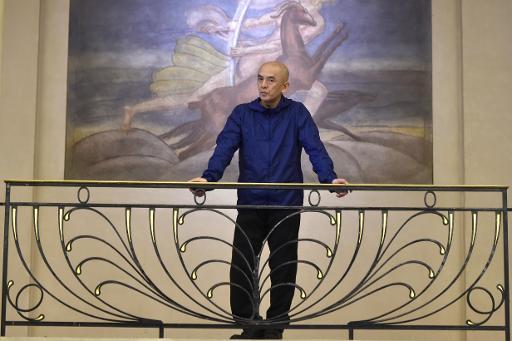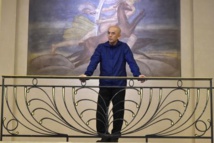The novel, a philosophical exploration on human intelligence and its limitations, has inspired numerous adaptations including a cult film by the Russian Andrei Tarkovsky and, more recently, by US director Steven Soderbergh.
"I've been drawn to this story for years," said Fujikura, a 37-year-old rising figure in avant-garde classical music.
"I don't think it's science fiction; it's a great story about the alien-ness which is deep within every human being," he told AFP.
Fujikura is known for his innovation of "spatial separation" in which he rejects the traditional seating structure of an orchestra and places musicians in various spots of the concert hall for musical effect.
For "Solaris," his first full-length opera, Fujikura seeks to emulate the strangeness of the planet by immersing the audience inside a wall of sound, similar to the sensation in a pitch-black cinema.
Lem's novel was not the science fiction of little green men. Instead, the ocean-planet Solaris possessed a mysterious, extraterrestrial form of intelligence that baffled human visitors.
In a counter-attack to the humans that reach the planet's surface, Solaris confronts them with visitors from the depths of their own memory.
Hence the scientist Kris Kelvin arrives in Solaris only to be tormented by meeting his late wife Hari, who had committed suicide. She turns into a sort of avatar of the invading scientist's memory, or indeed of his subconscious.
- 3D, and performance duos -
To bring "Solaris" to the stage, the opera employs duos -- one singer, and one dancer -- to portray each of the main characters: Kelvin and Hari, as well as Snaut and Gibarian, fellow human scientists on the station that is observing Solaris.
The audience is introduced to the mysterious planet through a three-dimensional video, which requires special glasses for the first 15 minutes of the opera.
The dancers include Rihoko Sato, a favourite performer for Teshigawara, as well as the choreographer himself and Nicolas Le Riche, the former star of the Paris Opera Ballet who retired last year.
Le Riche has grown close to Teshigawara over the years and danced in October 2013 to his piece "Darkness is Hiding Black Horses."
"Saburo is a conceptual artist and you shouldn't expect an extremely narrative opera, even if the text is quite explicit," Le Riche said.
"The singers are explaining the action and the dancers are there to give body, texture, substance and colour to personify this story," he said.
The Ensemble Intercontemporain, the French chamber orchestra that focuses on contemporary music, performs the score in the pit but Fujikura will be present at the soundboard to add a subtle electronic layer.
A computer will pick up random segments of the singing for a couple of seconds at a time, and send the sound "flittering away" in the concert hall, Fujikura said.
"We needed electronics because we are dealing with strangeness," he said.
In the case of the character of the dead wife Hari, she is portrayed as an "innocent girl, singing beautifully" but the effect "gives her something strange, because she has been dead for years!"
Fujikura worked on the project with technicians from Ircam, the Paris research institute on the science of music that was founded by contemporary music giant Pierre Boulez, a strong supporter of the younger Japanese composer.
"Solaris" will run from Thursday to Saturday at the Theatre des Champs-Elysees, the institution behind the revolutionary 1913 "The Rite of Spring" composed by Igor Stravinsky and choreographed by Vaslav Najinsky.
"Solaris" will head later in March to Lille in northern France and the next month to Lausanne, Switzerland, with discussions under way for performances elsewhere.
-------------------------------------------------------------------------------------------------------------------------
"I've been drawn to this story for years," said Fujikura, a 37-year-old rising figure in avant-garde classical music.
"I don't think it's science fiction; it's a great story about the alien-ness which is deep within every human being," he told AFP.
Fujikura is known for his innovation of "spatial separation" in which he rejects the traditional seating structure of an orchestra and places musicians in various spots of the concert hall for musical effect.
For "Solaris," his first full-length opera, Fujikura seeks to emulate the strangeness of the planet by immersing the audience inside a wall of sound, similar to the sensation in a pitch-black cinema.
Lem's novel was not the science fiction of little green men. Instead, the ocean-planet Solaris possessed a mysterious, extraterrestrial form of intelligence that baffled human visitors.
In a counter-attack to the humans that reach the planet's surface, Solaris confronts them with visitors from the depths of their own memory.
Hence the scientist Kris Kelvin arrives in Solaris only to be tormented by meeting his late wife Hari, who had committed suicide. She turns into a sort of avatar of the invading scientist's memory, or indeed of his subconscious.
- 3D, and performance duos -
To bring "Solaris" to the stage, the opera employs duos -- one singer, and one dancer -- to portray each of the main characters: Kelvin and Hari, as well as Snaut and Gibarian, fellow human scientists on the station that is observing Solaris.
The audience is introduced to the mysterious planet through a three-dimensional video, which requires special glasses for the first 15 minutes of the opera.
The dancers include Rihoko Sato, a favourite performer for Teshigawara, as well as the choreographer himself and Nicolas Le Riche, the former star of the Paris Opera Ballet who retired last year.
Le Riche has grown close to Teshigawara over the years and danced in October 2013 to his piece "Darkness is Hiding Black Horses."
"Saburo is a conceptual artist and you shouldn't expect an extremely narrative opera, even if the text is quite explicit," Le Riche said.
"The singers are explaining the action and the dancers are there to give body, texture, substance and colour to personify this story," he said.
The Ensemble Intercontemporain, the French chamber orchestra that focuses on contemporary music, performs the score in the pit but Fujikura will be present at the soundboard to add a subtle electronic layer.
A computer will pick up random segments of the singing for a couple of seconds at a time, and send the sound "flittering away" in the concert hall, Fujikura said.
"We needed electronics because we are dealing with strangeness," he said.
In the case of the character of the dead wife Hari, she is portrayed as an "innocent girl, singing beautifully" but the effect "gives her something strange, because she has been dead for years!"
Fujikura worked on the project with technicians from Ircam, the Paris research institute on the science of music that was founded by contemporary music giant Pierre Boulez, a strong supporter of the younger Japanese composer.
"Solaris" will run from Thursday to Saturday at the Theatre des Champs-Elysees, the institution behind the revolutionary 1913 "The Rite of Spring" composed by Igor Stravinsky and choreographed by Vaslav Najinsky.
"Solaris" will head later in March to Lille in northern France and the next month to Lausanne, Switzerland, with discussions under way for performances elsewhere.
-------------------------------------------------------------------------------------------------------------------------









 Home
Home Politics
Politics











